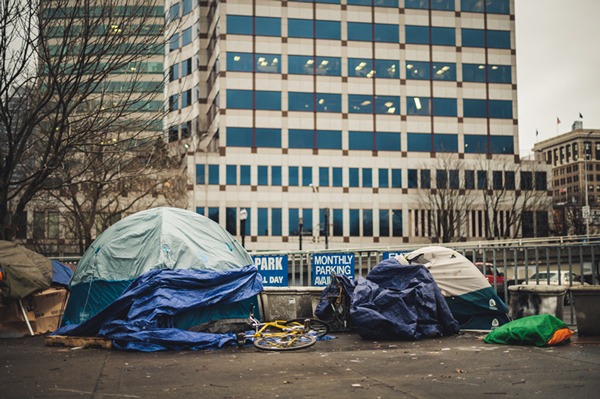Can’t find somewhere to live? Can’t pay for it? Get out! That means you!
Who?
As many renters and mortgage holders grapple with rapidly rising housing costs, the thought that you might join the 1 in 200 who are homeless is increasingly on people’s minds: 122,000 of us were recorded as homeless on census night 2021,[1] an increase of 6000 people since the 2016 Census even before the rapid increase in housing costs over the past 18 months.
You might not end up on the streets, along with the one in 16 of us homeless who are living in makeshift dwellings, tents or sleeping out. You might find supported accommodation, couch surfing, a boarding house or somewhere else temporary and/or very crowded. You probably had a hotel room to stay in during covid lockdowns, only to find yourself facing the street or in precarious accommodation again, and homelessness services are stretched thinner than ever.
If you are young, you could be among the almost one in four homeless who are aged between 12 and 24.
If you are a child you could be among the one in seven homeless who is under 12 years old. Or you could be a parent desperately trying to find somewhere for the kids and you, maybe having faced Domestic or Family Violence. Shockingly, childhood homelessness has risen faster than for any other group, and women and children represent 55% of the homeless population.
Or you could be aged 55 and over, as are one in seven homeless people.
You are slightly more likely to be male and homeless. But if you’re female your chances of being homeless have grown much faster than for men, and even faster if you’re an older woman.
If you are an Indigenous person the risks rise significantly. One in five people experiencing homelessness is an Aboriginal or Torres Strait Islander person, who are more than five times as likely to be homeless than for the whole population.
Or maybe you are just unlucky enough to live in the wrong part of the country – homelessness has risen by 45% in Tasmania since 2016.
Don’t think you’re homeless because you’re unemployed. You could be one of the many working poor. You have a one in three chance of being in the labour force while being homeless. If you’re homeless you’ve got more than a one in four chance that you’re working, and a one in eight chance that you’re working full time.
Causes
Since government investment in expanding public housing effectively stopped decades ago, it is no wonder you can’t afford anywhere to live. Social housing waiting lists now stretch to ten years in many parts of the country. And since it became much harder to get into social housing, it isn’t as nice or secure a place as it used to be to live in.
For low income households, rents have increased enormously, while stagnant wages haven’t increased purchasing power at the lower end of the income distribution over decades.
Solutions
In the past, federal governments spent as much as 4.5% of the budget to ensure everyone had a secure, affordable home. However, over time this commitment to housing has dwindled, and federal housing spending reached an all-time low of just 0.5% in 2019. To be clear, what is holding us back from ensuring all Australians are adequately housed is not any economic constraint, but political and social priorities.
Housing all Australians would not only be a great social achievement; for those that argue that it would be too expensive, reducing homelessness would save hugely on medical costs, expensive crisis accommodation and other supports that we only need when we are homeless or at risk. This could potentially create a net saving to the Budget. Housing people experiencing homelessness doesn’t only benefit homeless people, but would benefit us all financially and socially. However, this saving should be irrelevant – as one of the richest countries per capita in the world, we should be able to ensure everyone has a safe, secure, affordable and comfortable home, regardless of their financial position, or the financial cost entailed.
Solving homelessness is not impossible. Our experience during COVID-19 lockdowns shows that with the right political and social will, we can bring people off the streets. However, the long-term solution requires that we:
- Strengthen the National Housing and Homelessness Agreement between the states and the Federal government. This agreement should act as a roadmap for systemic reform in our housing system to ensure all Australians can be sure of an appropriate home, regardless of their circumstances;
- Treat housing as a basic human right;
- Massively expand the provision of social housing, both new and existing dwellings distributed throughout different neighbourhoods and close to jobs;
- Improve support services for homeless people, with secure long-term funding;
- Introduce rent stabilisation policies so that rents in the private market can’t suddenly become unaffordable;
- Strengthen security of tenure, conditions and quality for tenants, starting with the elimination of no-cause evictions;
- Reduce tax breaks for landlords, and used the increase in tax revenue to ensure a long-term fund for building and maintaining social housing;
- Increase welfare payments; and
- Ensure that industrial relations reforms enable the lifting of award wages.
By Margaret McKenzie
[1] Estimating Homelessness: Census, 2021 | Australian Bureau of Statistics (abs.gov.au)
Photo by Brett Sayles

